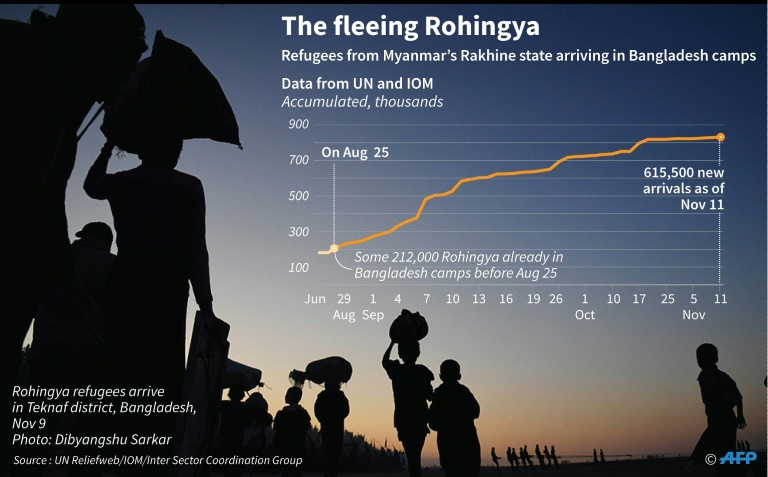IMF’s bad news about economic growth for SA, thanks to Trump tariffs
Torched villages and unharvested paddy fields stretch to the horizon in Myanmar's violence-gutted Rakhine state, where a dwindling number of Muslim Rohingya remain trapped in limbo after an army crackdown coursed through the region.
A rare military-organised trip for foreign media by helicopter to Maungdaw district — the epicentre of a crisis that exploded in late August — showed a landscape devoid of people, with the emerald paddy fields scarred by the blackened patches of destroyed Rohingya villages.

The fleeing Rohingya
More than 600,000 Rohingya Muslims have fled the area over the past two and a half months, running from a scorched-earth military campaign against militants that the UN has described as a “textbook example” of ethnic cleansing.
Myanmar, a mainly Buddhist country, has denied committing atrocities but has heavily restricted access to the conflict zone with the exception of brief government-organised visits.
Under the watchful eye of an army brigadier and border police, journalists on Sunday were able to speak to some of the several hundred Rohingya camped at the beach near Ale Than Kyaw village, hoping to flee across treacherous waters to neighbouring Bangladesh.
While the worst violence appears to have subsided, those left behind say they are trapped — unable to afford the boat fee, but without the means to eke out a living in the region
While the worst violence appears to have subsided, those left behind say they are trapped — unable to afford the $50 boat fee, but without the means to eke out a living in the region.
“We used to work in farming and fishing, but now the owners don’t want labour,” said 25-year-old Osoma, explaining that most Rohingya businesses and landowners have joined the exodus.
The young mother of three, carrying a month-old baby in her arms, said her family was not certain if life in Bangladesh’s sprawling refugee camps would be better.
“But we want to stay with the others who are there already,” she told AFP.
– Desperate escape –
Rakhine’s northernmost Maungdaw district was once home to around three quarters of Myanmar’s 1.1 million-strong Rohingya population, according to government figures.
The remains of a small burned-out village are seen among large unharvested fields in Rakhine
Aid workers estimate that only some 150,000 remain there, with other communities living further south.
With no one left to work Maungdaw’s fields, huge swathes of verdant farmland are at risk of rotting — a cruel irony given the severe food shortages in aid-dependent Rakhine and the squalid refugee camps across the border.
Myanmar says it has trucked in workers from other parts of the state to harvest 70,000 acres of abandoned rice paddies.
But some stretches of untouched fields have already started to turn brown in the mountain-studded region.
The media trip to Rakhine comes amid mounting global pressure on Myanmar over its handling of the crisis, with US Secretary of State Rex Tillerson set to visit the capital on Wednesday.
The top American diplomat is expected to take a firm tone with the country’s powerful military leaders, whom he has deemed “responsible” for the crisis.
Several hundred Rohingya are camped at the beach near Ale Than Kyaw village, hoping to flee across treacherous waters to neighbouring Bangladesh
Meanwhile, on the shores of Rakhine, some desperate Rohingya are taking matters into their own hands.
Ro Shi Armad, 18, has teamed up with several other families to build a flimsy-looking raft using plastic containers and bamboo.
Scores of refugees have drowned in recent months while attempting the perilous journey to Bangladesh.
“We’re not worried if we die on the way over,” the teenager told AFP.
“What else can we do now?”
Download our app